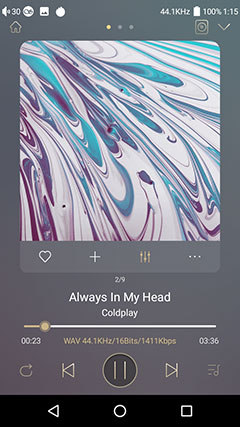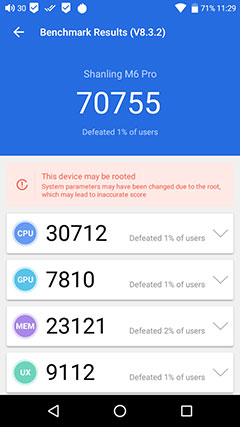Software
Android
The M6 Pro 21 runs on an open Android 7.1 system which is now dated with patchy Google support. You can use Pure APK or other services to load unlimited apps onto the player which sometimes I prefer to Google Play given it does not have any regional blocks for certain apps.
Thankfully, the matured UI/UX experience is quite smooth with little in the way of glitches and bugs. This is a friendly and responsive setup. You will also see a lot of customization like the drop-down menu icons that make navigation more intuitive than the original M6 Pro interface that you may sometimes accidentally press.
Shanling always offers firmware upgrades that will polish the user experience and further reduce any bugs found by users. However, out of the box, there are hardly any glitches that I experienced so multiple errors fixes might not be required on the new player’s OS.
You can always check if there are new updates via OTA by pressing the lightbulb app icon and within a few minutes, you will be upgraded to the latest firmware if prompted.
Performance Measurements
Running AnTuTu’s latest version we are getting similar scores to the original M6 Pro. Again it is not the fastest in class, that accolade belongs to the FiiO M11 Plus LTD.
However, it is more than sufficient to provide a smooth UI experience and faster than some competing DAPs such as the R6 Pro and the DX220. It is also faster than the original M6 line.
The in-app speed aligns with what was experienced on the M6 Pro. Intensive 3D gaming results in quite severe frame drops but simple mini-games like Fruit Ninja are smooth. Just don’t expect to throw in anything graphic intensive with satisfying results.

Features
Prime Mode & ALGO
To bypass Android limitations and not downsample your audio Shanling have implemented their proprietary AGLO technology, (Android Global Lossless Output), supporting up to 768kHz sampling rates.
This is an important feature customizing the Android system down to the root level to ensure there is no unnecessary conversion that hinders the sound performance. You can also switch to the PRIME mode which force-kills other apps in the background and focus on playback via Shanling’s own music app.
Synclink
This is one of the major features you can enjoy with Shanling’s system even for the lower-end models. You can have access to the Synclink function enabled in the music app wireless menu.
Switching that on and downloading the corresponding Shanling control app on your phone allows you to remote control the player via BT, without the need to take it out of the pocket every time you want to skip the song.
Single & Dual DAC modes
On the drag-down menu, you can quickly toggle between single and dual DAC mode instantly. As expected the dual DAC mode is more resolving and the single DAC mode is comparatively smoothed out.
I will always recommend using the Dual DAC mode unless the battery is running low. However, if you just want some background music for a long ride, the single DAC mode is lovely and will smooth out the signal and sound the more relaxing of the two modes.

Wired Performance
The M6 Pro 21 supports USB-DAC and OTG. You can toggle between USB-DAC and storage modes in the drop-down menu for audio output from your PC or for file transfer. If you are connecting to an external DAC remember to turn the volume low to avoid damaging earphones by high output.
You can also use an OTG card reader/ thumb drive to quickly transfer songs to the M6 Pro’s SD card or internal memory. It also supports playing files on an OTG storage device.
Wireless Performance
Bluetooth
The Hi-Res wireless certified M6 Pro 21 runs on an older Bluetooth 4.2 system but it supports all of the popular Bluetooth codecs, allowing you to connect to all the latest Hi-Res receivers or earphones. Airplay is also supported so you can stream from your iPads and Macs as well.
Connecting to TWS or Bluetooth headphones is smooth and the M6 Pro 21 can work two-way as a remitter or receiver for LDAC and SBC codecs when you select “Bluetooth Amp mode” in the Bluetooth settings. For aptX HD and HWA, it can transmit the signal outwards only.
The experience is similar to the original M6 Pro and on the body of the device, you will find an LED indicator above the volume wheel that shows the BT connection status. The color codes are green for LDAC, SBC Blue, aptX purple and aptX HD will get you yellow. If you are charging the M6 Pro 21 it will show a red color.
LDAC / aptX HD
Connection to the Bluetooth dongles is instant. You can select the prioritized Codec for wireless music transfer in the settings under “Audio” > “Wireless playback quality” at the bottom. Pairing is relatively straightforward, for example, the FiiO BTR5 and the HiBy WH2 both connected quite smoothly.
The connection is very stable and the signal doesn’t drop even when moving fast from the device. You can use the M6 Pro 21 to stream to your HiFi system and to free it from being docked.
WiFi
The M6 Pro 21 is fast with online applications on a WiFi connection. With the 2.4G/5G module inside and quite a strong antenna, it is very responsive when streaming and browsing the web.
When you use the NAS access functions via the Shanling Music App the experience is also surprisingly fast and smooth with little delay time, so it is quite an ideal streamer at home.
Sound Impressions
Summary
After the M3X and M6 Version 21, this is the 3rd DAP from Shanling that moves to the ESS solutions as a result of AKM chipsets being out of production.
Out of the box, the newer 2021 rendition of the M6 Pro sounds more open and resolving while boosting an even more dynamic performance than the original build. The house tuning is dense, with meaty mid-lows, and a precise treble are all still going strong after switching to the ESS chipset.
I am immediately convinced it is an upgrade instead of a spin-off or modified version, especially with the level of control and precision that is enhanced over the original build. An extra note for lineout users, the output is extremely strong so make sure you turn to the lowest volume on the amplifier.
Timbre
The M6 Pro 21 does have some similarities with the original M6 Pro tuning such as a naturally sounding timbre with great tonal balance. However, it is audibly brighter with a stronger mid-treble range outline, firmer in the upper mids with more dynamic and energy in both the low-end and treble.
Bass
Shanling manages to give some good air to the M6 Pro 21’s bass. There is good firmness, density, and an expressive decay that adds richness. The attack speed and bass decay speed feel just right to render enough space and energy. It sounds very responsive yet not overly analytical or dry at the same time.
Mids
The mids frequency range is tight, dense and it almost confuses me if this is using an ESS solution. The only giveaway is the upper mids which are touched up with extra crispiness. The vocal has a good stereo image, pushed back and allowing more room for more instruments to fit in.
The mids are rather smooth like the M8 with the focus more on the dense mid-bass and upper vocal range which strengthen the instrumental fundamental.
The tuning works well with well-mastered tracks, allowing the listener to pick up details from all over the frequency spectrum. Piano works and instrumentals are particularly enjoyable on this tuning.
Treble
While the treble is sharp and well outlined the level of control is strong even on higher gain. When Shanling moved to use ESS solutions I am worried if it will sound too dim in the treble or overly smoothed out. However, what I hear completely puts away my worries.
The upper mids are very smoothly articulated to the treble which is slightly forwarded yet not sharp. There is good energy around the 5-7kHz region which adds clarity and definition. Yet the tuning is very well controlled and resolved, nicely rounded without killing the air and openness in staging.
The background noise is amazingly quiet. While there is a lot of dynamics and it doesn’t sound boxed in. Even with ESS chipsets, Shanling manages to infuse their house tuning with good technical qualities and step up the performance in favorable directions.
Staging
With an extended treble and a lot of raw power in the output, the M6 Pro 21 gets an expanded stage rendered as well as accurately imaged vocals. The staging is stereophonic and defined, instruments are pinpoint accurate with good realism and texture.
With drum works, you can hear how well the M6 Pro 21 positions the different elements within. The snares are tight, the kick drums get good air, and nothing sounds hollow or weak.
With vocals, it is perfect with opera works that need openness and sharpness to sound like the real deal. You get that density that brings to you glass-breaking tension as if you are listening in an opera house that has acoustic measures done right to keep the strength and power in instruments and voices while preserving the reverbs and air.
Click on page 3 below for pairings and select comparisons





